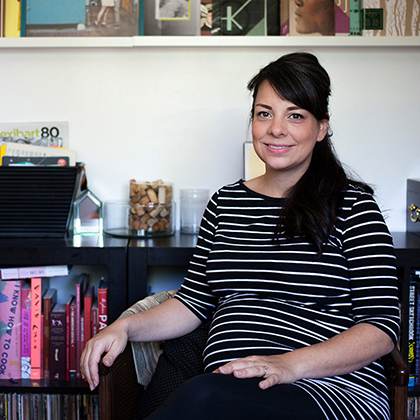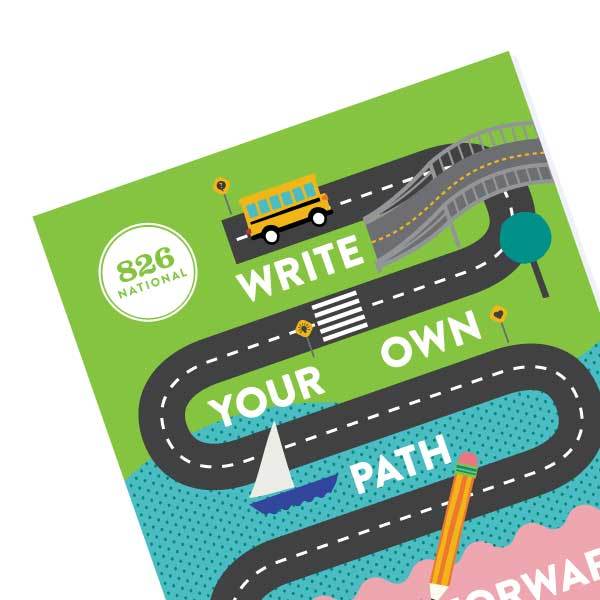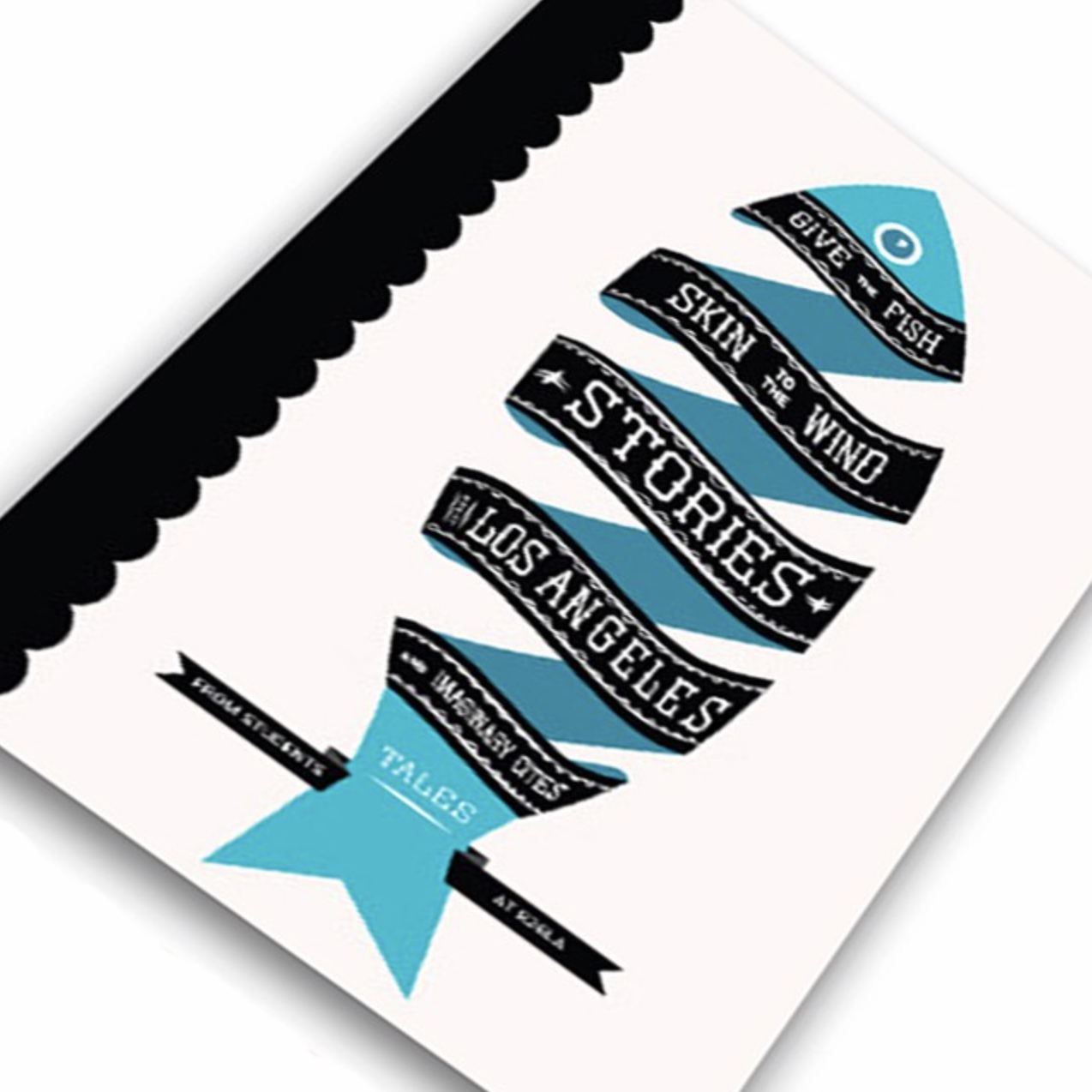Artist portrait by James Jenkins

Artist portrait by James Jenkins
Shannon Doronio
Los Angeles based designer
Interview by James Jenkins
JAMES JENKINS: It is April 2, 2016 and I’m interviewing Shannon Doronio at her home in Chatsworth California. Tell me about your design work?
SHANNON DORONIO: I have three bottom lines that I approach in my design life: I enjoy the work I do, I try to fix the things that are broken and I must be able to have a family. Those three things are what drive the kind of work that I choose and the kind of work that I don’t pursue.
JENKINS: Do you have projects outside of your design practice that inform your studio work?
DORONIO: Because I just love doing things by hand, I try as much I can to find a way to incorporate handmade elements into my designs and illustrations. Recently, I designed an annual report for 826LA. I used to love doing collages with construction paper. So, I hand cut a bunch of shapes out of black construction paper and scanned them and then used all of those pieces as my toolkit for building the illustrations. It was fun and I loved seeing
evidence of the hand in the illustrations.

Annual Report, Client: 826LA 2016
JENKINS: What does your practice of creativity involve? Can you talk about some specifics?
DORONIO: I try to keep it down to four simple steps, ask, look, think and make. At the beginning of any process, I try to ask myself as many questions as possible, or ask my client as many questions as possible. Just to find out what the knowns and the unknowns are. Then I take a look at similar visual landscapes. If there’s something in the past that is connected to this, I look at it. I look at what’s happening now, or maybe I look at things that are really in left field that might influence how I approach the project. Also, I think about possible outcomes. That’s usually where I start sketching. I like sketching in a sketch book before I hit a computer, because you can just get those bad ideas out fast and dirty and keep moving on. Once I have found something or landed on a plan, then I start making. For me, design is 90% asking, looking, thinking and 10% actually making.
“For me, design is 90% asking, looking, thinking and 10% actually making.”
JENKINS: Where do you look for creative inspiration?
DORONIO: You mean how I get started thinking about a project?
JENKINS: Yeah, or maybe how you approach a project, or how a project unfolds.
DORONIO: I’m an avid Pinterest user, especially being a mom. You kind of have to binge inspire when you can. If the baby is napping and I’m doing something or waiting for something, then I can just grab my phone and start flipping through Pinterest or a series of blogs that I follow. I also try to look outside of design for inspiration, and that’s more about how other people approach what they do. I just call them the spirit animals of design. I enjoy learning about how another person makes something or does anything really well. Then see how I can apply that to myself and my work.
JENKINS: It seems you take every moment you can to find things that inspire you.
DORONIO: Absolutely. I try as often as I can to get out of the house and go out to a museum and actually get in front of some stuff in the world. My daughter is 18 months old now. When she was first born, I felt like I spent the first 3 months of my life in a rocking chair and I was so grateful for my phone. The minute I would sit my daughter down she would start crying. So, all right, at least I can sit here with my phone and look at things and read things to keep that part of my brain going.
JENKINS: That’s a great solution. Do you design every day?
DORONIO: It’s funny, I say yes and no. There are definitely days where I wake up in the morning and I think, “I am not going to look at anything or do anything today because I just need to cleanse the palate of my brain.” Then there’s that moment where you’re sitting in traffic or you’re waiting in a line and all of a sudden you think of something and it’s perfect for something that you’re working on. I actually have a sorely neglected blog called “at work right now” because when you are a designer, you are always at work. When you’re a visual person or you’re a making person, you’re always at work even when you’re trying not to be, your brain is still working.
JENKINS: What is the role of chance in your creative practice?
DORONIO: I love the role of chance. I think that’s why I like bringing in the evidence of the hand but sometimes leaving some of it up to technology. I feel like we view technology as this really precise mechanical thing and I feel there’s ways to exploit it and play with it. I remember when I was in design school we had this junkie color copy machine and I discovered all these settings on it where you could turn on and off different inks. Just as an experiment, I wanted to do a four-color process on this machine. I would stick one sheet in and just run the yellows and then stick the same sheet back in and run the magenta and compare what that looks like compared to if you just put the image in and hit print. I think there’s lots of fun ways to play with technology and use it for unexpected things.

Give The Fish Skin To The Wind, Client 826LA 2011
JENKINS: Do you ever struggle with the creative process?
DORONIO: Always, I don’t know if you can be a human being in design and say you’ve never struggled. I would be so suspect of anybody who says that.
JENKINS: I ask the same question of everybody, it’s very interesting.
DORONIO: Yeah, I’m really curious to see if anybody says they have no struggle. There’s some stuff where you totally feel like you nailed it and the clients are going to be super excited. When you show your solution to them, it’s quiet and there’s not much of a response. Those moments are the ones that I think are a little bit surprising. Then there’s times when you can force yourself to sit at your desk and try to work when nothing is happening, and you just keep sitting there and keep doing the same thing. I just get myself out of that zone. When I feel the struggle, I give myself a break.
JENKINS: We’re sitting in a beautiful studio that you have in your home. You have talked about raising your daughter and being a mom that when you have a free moment you access your creative ideas using your phone. When you step into the studio, is this your creative zone?
DORONIO: Oh, yeah, yeah, I have a part-time nanny and my husband and I trade off care taking. It’s pretty rare that both of us are in this room at the same time. It’s a really nice quiet place, but I definitely need solitude in order to get some real work and real thinking done. I’m super appreciative to have that.
JENKINS: How do you recognize a good idea?
DORONIO: I feel like it’s physical. When you have a good idea, you just know it, you feel it. “Oh, I have to go and make this.” You get really antsy, you’re just excited, and you just have to go work on it as quickly as possible. You know you’ve hit the bad ideas when you’ve spent hours and hours and you’re still not feeling it, something is just not working, it needs to be reevaluated. I feel like the good ideas happen really easily.

Rhythm Natives ST Album, Client: Rhythm Natives 2011
JENKINS: How do you know when a design project is finished? Can you talk about the decisions that decide that?
DORONIO: When you’re working on a personal project, it’s a lot harder to know when your project is done. I always ask myself if I’m trying to do more and if it feels like I’ve hit a slump in productivity and I’m still trying to do more, then I start asking myself if I really need to do more, or if the project is done and it just needs some fine tuning. When it’s a client’s project, I look back to the performance criteria. As I work, I’m checking everything that I’m doing against that list and once I’ve hit everything that I need to hit, I know I’m really close to a finished project.
JENKINS: Do you consider history or contemporary trends when you are creating or designing?
DORONIO: Absolutely. I was a graphic design major and art history design minor. Otis structured their design program that way because, I feel especially in design, you really need to have a strong understanding of art history and contemporary art. Art history takes a little bit more digging and a little bit more of knowing what to look for. I always think about how Urban Outfitters is famous for putting out stuff that references history in a really horrible way. They did what was supposed to be a tie-dyed series of college t-shirts. For the Kent State t-shirt, they chose red ink and the sweater looked like a blood splattered Kent State sweat shirt.
JENKINS: Terrible decision.
DORONIO: Really horrible decision. I believe anytime you’re designing anything, you should take a look at history and the past and see if there’s anything that aligns to help tell your story or anything that is malaligned that may hurt your story.
“The work I appreciate most is when you can tell somebody is not trying to be cool. They’re not trying to hit a style, they’re not trying to live in some era of design. They’re just doing something that feels right for them and it’s working out really well.”
JENKINS: As far as the history of graphic design, is there any movement or era in design that has influenced you?
DORONIO: The work I appreciate most is when you can tell somebody is not trying to be cool. They’re not trying to hit a style, they’re not trying to live in some era of design. They’re just doing something that feels right for them and it’s working out really well.
JENKINS: Are you satisfied creatively?
DORONIO: That’s so funny, yes and no. I really like all of the stuff I work on like my teaching, client work, I’m really happy. Then there’s always, I want more. I would love to have time to pursue more personal projects. That’s probably the only example where the designer in me is a little bit starved. I have a list of design projects that I’d like to make that I just never seem to have the time for.
JAMES: When you were in design school or at any point in your studies, did you have a mentor?
SHANNON: I did, I had a few mentors. I actually purposely sought out mentors whose life and career path looked like something I wanted to do. Anna Laurente was one of them, a super strong female who is really great at what she does. She has this thing that I think a lot of especially female design students can learn from. Growing up in the ‘90s right girl movement and feminism, there’s this thing where if you’re a woman and you’re confident, you’re seen as either “butchy” or pushy. Anna Laurente would walk into a room and be totally confident and still totally feminine and just super powerful and I love that about her. I talked to her a lot and got a lot of valuable advice. I think meeting Stephen Buker was also influential. He talked about how not to trade off your happiness for money, when it comes to work. Not taking the big shiny, fancy job that’s going to eat up your life and suck out your soul, so that you can have a brand new everything. It’s more about pursuing work that you know you’re going to enjoy and you’re going to love. Keep your life at a scale that’s manageable enough so you can say yes to that stuff and not have to say yes to the work that you don’t want to do. That was really inspiring.
JENKINS: Do you ever think about your legacy and what that will be?
DORONIO: That’s a tough one. I don’t know. For me, that legacy is what I’m already enjoying, the things I do that make me happy. I spent a lot of time as kid watching my parents come home really pissed off, really angry, because they hated their jobs. I can’t even tell you how many times I heard my parents say, “I hate my f***ing job.” That was a big thing for me. I think that probably steered me away from a traditional route and pushed me toward trying to take what I love and make it a career. I hope that in being happy with what I do influences my kids.
“I hope that’s something I can impart on my students. I want to teach them that they can use design to help fix things they want fixed.”
DORONIO: The thing about fixing broken things, I just feel like I saw a lot growing up. My dad came here in the trunk of a car in the ’60’s. Nobody in my family ever went to college, I was the first person and I saw a lot of disparity and lack of opportunity.
One of my clients is 826LA and then the parent organization, 826 National. I started working with them in design school. They are a non-profit that supports education and leveling out the playing field between really well-funded school districts and really great performing schools and then trying to narrow the gap in neighborhoods where there aren’t as many resources for those schools. I just started volunteering with them and then they wound up turning into a client and I do a ton of work for them and it’s just super fulfilling.
I just always hope that the work I’m doing with them helps pull in funders and helps bring attention to the cause. We’ve done projects where we’ve designed a full student publication, so we’re giving visual form and shape to the words of inner-city high school students. I hope that through treating these kids’ work as important as any other work, it elevates it and their voices. It’s kind of helping, helping to fix the broken things. I hope that’s something I can impart to my students. I want to teach them that they can use design to help fix things they want fixed.

When The Moon Is Up, Client: 826LA, Locke High School Class of 2016
JENKINS: What advice would you give to young designers as they begin their careers?
DORONIO: I think there’s a lot of self-consciousness. You just get so caught up in the fact you have work and you show up for a “crit” and you’re afraid other people are going to be judging your work. I’m always reminding my students that critiques aren’t about judgment, it’s about learning from how somebody else solved the same problem you have and that’s what everybody is interested in. Don’t try to be cool, just try to learn and enjoy what you do.
The other challenge is to keep going because it’s easy to get disappointed especially when you’re making bad stuff, you just make a ton of bad stuff.
I always go back to the Ira Glass story where he talks about how everybody in the beginning is bad. Everybody makes horrible things and there’s this gap between what you like and what you’re making. You know that this gap is there and it’s discouraging but you must keep going. If you see work you like, it’s because someone put in many hours getting there. If you just commit yourself, you’ll get there too.
More of Shannon Doronio’s work can be viewed at: parallel-play.com
Article edit by Mark Daybell

THE PRACTICE OF CREATIVITY
©2015-2020 All rights reserved
